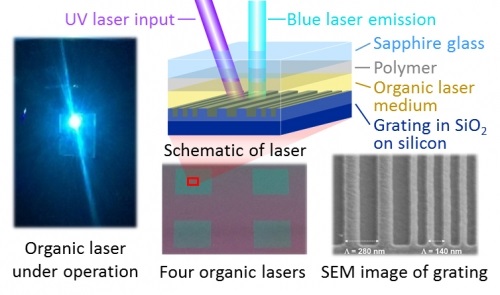2017.05.10
New research could make lasers emitting a wide range of colors more accessible and open new applications from communications and sensing to displays. Researchers at Kyushu University’s Center for Organic Photonics and Electronics Research (OPERA) reported an optically pumped organic thin-film laser that can continuously emit light for 30 ms, which is more than 100 times longer than previous devices and marks a major step toward the realization of organic lasers driven directly using electricity.
Organic thin-film lasers use a thin layer of organic molecules as the laser medium, which is the material in the device that actually produces lasing by emitting and amplifying light when excited with an energy source. In this case, the energy source was intense ultraviolet light from an inorganic laser. A promising feature of organic thin-film lasers is the possibility to use different molecules to more easily realize lasers emitting light in parts of the visible and infrared spectrum that are difficult with inorganic lasers. However, thermal degradation and loss processes have greatly limited the duration of emission in organic thin-film lasers.
By combining three strategies, the researchers were able to reduce these detrimental processes and extend the lasing duration. To reduce major losses originating from the absorption of laser emission by packets of energy – called triplet excitons – that build up in the organic laser medium during operation, the researchers found an organic laser medium with triplet excitons that absorb a different color of light than that emitted by the laser.
Thermal degradation caused by heating of the lasers during operation was reduced by building the devices on a crystalline silicon wafer and gluing a piece of sapphire glass on top of the organic laser medium with a special polymer. The silicon and sapphire, which are good heat conductors, help to quickly remove heat from the devices while at the same time encapsulating them. Finally, through optimization of a frequently used grating structure – called a mixed-order distributed feedback structure – placed under the organic laser medium to provide optical feedback, the input energy needed to operate the lasers was reduced to new lows, further lessening the heating.
Development is ongoing to sustain the emission for even longer durations and overcome the additional problems that arise under electrical excitation.
For more information about this research, see “Towards continuous-wave operation of organic semiconductor lasers,” Atula S. D. Sandanayaka et al., Science Advances 3, e1602570 (2017). DOI: 10.1126/sciadv.1602570
Journal References
Toward continuous-wave operation of organic semiconductor lasers ,Science Advance,
10.1126/sciadv.1602570












